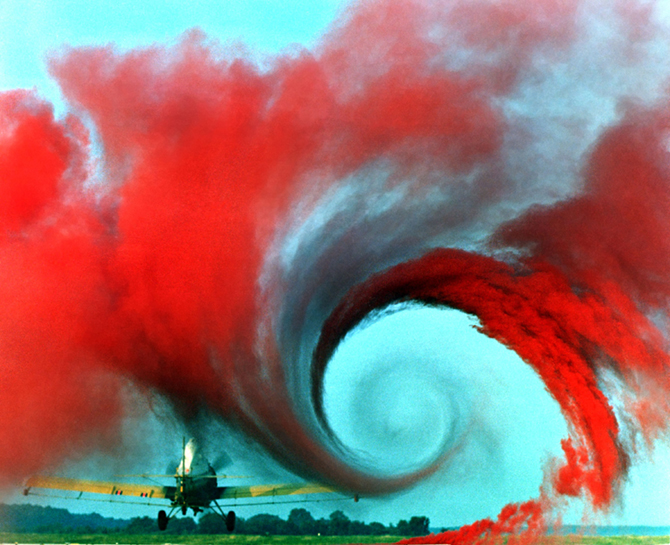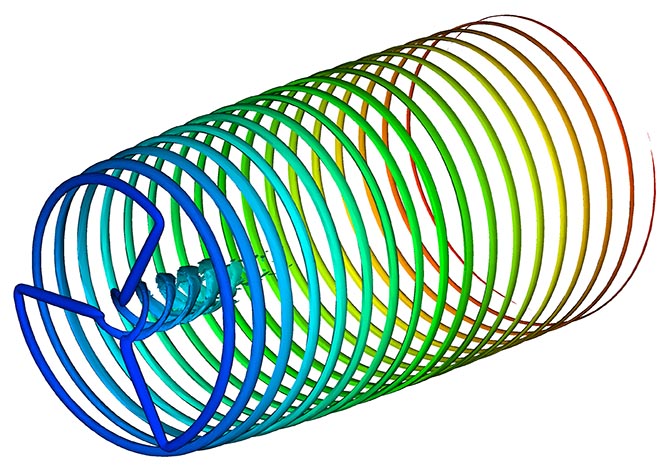Improving wind farm design
Researchers from Uppsala University, KTH Mechanics and the Technical University of Denmark are studying and modelling the vortices created by the blades of wind turbines in order to design wind farms that are more efficient and effective.
by Stefan Ivanell, Dan Henningson and Philipp Schlatter, KTH Department of Mechanics
Nowadays responsible industrialised nations are placing more and more focus on developing clean sources of power that neither destroy our natural resources nor leave a legacy of poisonous waste for our descendants. Over the last two decades, Sweden has seen a steady increase in the use of wind power, with yet more wind farms under construction, and, during the last decade, a drastic increase in the number of planned wind farm sites has been proposed worldwide.
For wind farms to be as effective as possible, they need good designs for the turbines that “harvest” the wind. If one considers the enormous size of typical wind turbines, it becomes obvious why it is economically impractical to test a range of different designs by building them all physically. Consequently we rely on mathematical modelling and simulations to predict suitable designs for wind turbines and for the layout of turbines in a wind farm. As you can imagine, this involves both complex modelling of the airflow in and around individual turbines and also between multiple turbines. However, many issues related to the analysis of the airflow in these situations still need to be understood in much more detail.

For example, when air flows past an object, a swirling flow of air (known as a vortex) can be created. With wind turbines, vortices arise as a result of the air flowing past the roots and tips of the turbine blades. The tip vortices or spirals then continue moving in the direction of the prevailing wind, which means that, in a wind farm with multiple turbines, the rotating air mass of a tip vortex can encounter one or more turbines downwind of the initial turbine. Thus the flow of air arriving at the downstream turbines is likely to be significantly different to the direct flow of wind that the initial turbine experiences. This can result in damage to the blades of the downwind turbines and can also reduce the amount of power that is generated by the turbines.
Not surprisingly, there are many factors to be taken into account when trying to model these processes, including the detailed flow physics associated with the instability of the tip vortices that are produced or shed from the turbine blades, the interactions of these tip vortices with downstream turbines (which affect the overall amount of power that is produced), and the influence of atmospheric boundary-layer density stratification and associated turbulence properties. Understanding the dynamics of tip vortices and their interactions when multiple turbines are present is absolutely crucial to improving our current understanding of wind turbines and the associated modelling.

All of these phenomena need to be understood and subsequently incorporated into the mathematical models used to design wind turbines and wind farms. This vital area has given rise to a large amount of research dealing with the modelling of wind farms. In Sweden, research on wind power is being coordinated by STandUp for Wind (which is a collaboration between researchers at the KTH Royal Institute of Technology and Uppsala University that is led by Stefan Ivanell), and through a relatively new programme which is funded by the Swedish Research Council (VR) and led by Dan Henningson from KTH. Close collaboration between research groups within a Nordic consortium from Sweden (KTH and the Gotland campus of Uppsala University) and Denmark (Technical University of Denmark) has led to interesting studies on the topic of tip vortices. For instance, a relationship between ambient flow properties and the length of the tip spiral vortices has been established. The figure above illustrates one of the outcomes of a new implementation of a wind turbine, showing the tip and root vortices, and how they slowly decay further downstream. Previous work by the group from KTH has established new knowledge about how the tip spirals interact under different ambient conditions, and proposed a model of how far downstream these vortices persist.
Having established accurate ways of simulating individual turbines, the next step, both within the Nordic consortium that was mentioned earlier and in the recent VR-funded framework programme, is to consider what happens in a wind farm where we have multiple turbines. Wind turbines placed downstream of other wind turbines have a reduced power output due to the greater turbulence in the approaching airflow. To optimise the layout of our wind farms, we must develop a better understanding of the airflow surrounding a single wind turbine, and then extend that to understand what happens in a wind farm where the air flows around and between multiple turbines. This will enable us to realistically model complete wind farms and thus give better estimates of their total potential power production.
Within these projects, the airflow for a wind turbine is analysed using higher-order numerical methods implemented in two sets of computer code, Nek5000 and SIMSON, which run on massively parallel computer systems such as those at PDC. Often simulations like this divide the relevant area (such as the blade of the wind turbine) into a mesh of points, and then performing calculations to work out what happens at each of the points. However using this approach for the wind turbine blades would be too costly in computational terms when it comes to achieving the required level of detail. Instead the researchers are modelling the wind turbines as body forces (that is, forces that act throughout the volume of a body – like gravity – rather than just at the point of contact – like friction) using a particular technique known as the actuator line method (ACL). With this method, the body forces mimic the action of the blade on the incoming flow of air. Thus the bulk of the supercomputer computational resources can be allocated to resolving what happens when the air has flowed past a turbine, that is, in the turbine wake flow. Using the geometric flexibility of the Nek5000 code, single turbines (in cylindrical grids) as well as turbines close to surfaces and entire wind farms can be implemented. Stefan Ivanell and Philipp Schlatter, along with other researchers from KTH, intend to use the Nek5000 code to perform detailed comparisons of experimental setups to improve the engineering predictions for large wind farms.